This past year, I had the privilege to travel to the Kingdom of Cambodia to visit the great temple complex of Angkor Wat. For those not familiar with Angkor Wat, it was built in the first half of the 12th century and is still today the largest religious structure in the world. However, Angkor Wat is but one of hundreds of temple complexes many crumbling ruins spread about the countryside around the present-day city of Siem Reap. For those fortunate to visit the area, the best means to travel about the temples is via a rather primitive means of transportation – the Tuk Tuk. The best way to describe a Tuk Tuk is to think of a rickshaw pulled by a moped. Most Tuk Tuk’s have a roof spanning two facing seats. Depending on the size, two to four individuals may ride comfortably. But there are variances to Tuk Tuk’s. At the high end of the market are elaborately hand carved and highly lacquered versions – a work of art unto themselves. But generally, the materials and ornamentation are modest – especially for the Tuk Tuk’s used for local traffic. Although prices vary, for somewhere around $12 you can rent a Tuk Tuk and driver for most of a day. Drivers are overly accommodating and are more than willing to run errands (keeping a supply of cold water is a must in the Cambodian heat), recommend restaurants, and generally take care of any issues that might surface during a day’s activities.
Based simply upon the above description, you might be lured to thinking a ride in a Tuk Tuk to be the equivalent of a peaceful carriage ride. You would also be most assuredly wrong. Tuk Tuk’s go fast – probably topping out around 30-40 miles per hour. But as a passenger, it feels like you are pushing sixty as you careen around corners and jostle across well-worn paved streets and dirt roads. Not only are you bouncing about, your driver weaves and bobs in and out of traffic with a reckless abandon. The Cambodian driver thinks nothing about shooting through congested traffic or looping over onto the wrong side of the road when the opportunity presents itself. Without a whisper of an apology, Tuk Tuk drivers cut each other off, skirt pedestrians by mere inches, and shoot right in front of trucks or cars without hesitation. Viewed from above, it must look completely chaotic. Vehicles and pedestrians bustling around each other like a horde of bees stirred into a frenzy. Yet strangely in this craziness, I never once witnessed an accident or an incident of any kind. No driver or pedestrian screamed out in anger or even displayed the slightest irritation with each other during my two-week stay. Crazy as they may be, the rules of the road (or lack thereof) are universally accepted and adhered to on the Cambodian roads.
As a process improvement practitioner, I could not help but mentally generate a list of ideas to tame the chaos and deliver a significantly safer experience for the travelers. If only stoplights and basic traffic rules were utilized, there would be substantial improvement in the system. Or would there? As I watched the scene play out everyday for two weeks, I came to appreciate the Cambodian twist on transportation. While every ounce of my being wanted to introduce order, the system basically worked – and it worked pretty darn well. Travellers got to their destination rather quickly and without any noted incidents. The system operates without the massive infrastructure costs associated with a modern transportation system and exists without any controls or hidden costs. Tuk Tuk’s and the Cambodia driving experience are emblematic of a culture that embraces chaos. For most of their modern history, Cambodia has suffered under authoritarian and corrupt governments. The general population is almost accepting of this situation and lives an agrarian lifestyle much as they always have. Infrastructure investments and consistently applied laws are foreign concepts. As a result, the Tuk Tuk system grew up to fill the need for localized transportation.
The Cambodian Tuk Tuk system is similar to what consultants and process improvement experts uncover on a daily basis. As we dig into the operational structure of an organization, we uncover areas lacking deliberate process design or where ambiguity appears to reign. We invariably push forward trying to install structures and process to make operations more defined and predictable. Although we may risk building improvements where the costs outweigh the potential benefits – we simply cannot help ourselves.
The performance of any system or process is dependent on a number of factors. As process practitioners, we naturally focus on having appropriately trained employees, a production process that delivers the right output, and controls to make it repeatable and sustainable. What we often overlook is the cultural aspect of performance. Environmental norms and how they impact our process work are critically important to delivering successful outcomes. The current Cambodian environment is the result of historical ebbs and flows. Cambodians have suffered through countless regime changes over the years. Corruption and bribery remain components of their society today. Consistent rules are not part of the fabric of their society. It’s a culture based upon doing what you can to the best of your ability and hoping things work out. Changing the norms in their culture would entail a massive adjustment to their lifestyle. When viewing their transportation system, instituting elements of a modern transportation system would be overly expensive because there is not any infrastructure today to base it upon. And operating such a system would require far greater active management than exists in any facet of their society today. It is a system not readily able to be changed.
As part of assessing improvement opportunities, an extremely important consideration is if the improvement will succeed given the existing environment. In the case of the Cambodian Tuk Tuk, I believe the answer is probably no. But an equally important question is if it makes sense to even try. Are there are intangible benefits to the current state? In the case of the Tuk Tuk, the experience of careening around Cambodia’s streets is part of what makes a visit memorable. Speak to anyone who has explored Cambodia and they will invariably talk about the magnificent temples and their excitement jostling about the Cambodian countryside in a Tuk Tuk. As proponents of change, we need to remember that on occasion it is better to avoid meddling with what works than to promote ideas and improvements that are not yet ready to be accepted and may well not deliver additional value.

















